This tutorial will show you how to create a bootable USB flash drive that can be used to install Windows 10 with or without UEFI.
 OPTION ONE
OPTION ONE 
Use Media Creation Tool to create Bootable Windows 10 USB for Legacy BIOS and UEFI
This option will use the Media Creation Tool from Microsoft to download an ISO file and create a bootable USB flash drive that is 32-bit, 64-bit, or both, and be used to install Windows 10 with or without UEFI.
Before you begin
1. Click/tap on the Download button below to go to Microsoft, and click/tap on the Download tool now button at Microsoft's site.
2. Save the MediaCreationTool1809.exe file (version 10.0.17763.1) to your desktop, and run it. (see screenshot below)

3. If prompted by UAC, click/tap on Yes.
4. Click/tap on Accept for the license terms. (see screenshot below)
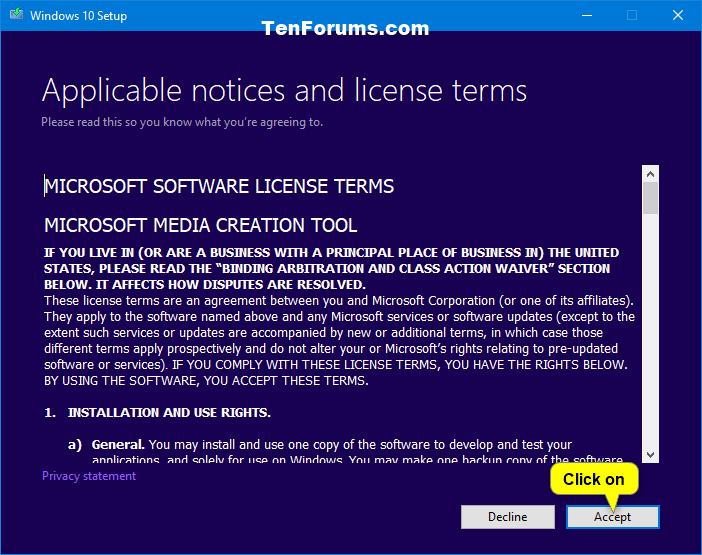
5. Select (dot) Create installation media (USB flash drive, DVD, or ISO file) for another PC, and click/tap on Next. (see screenshot below)
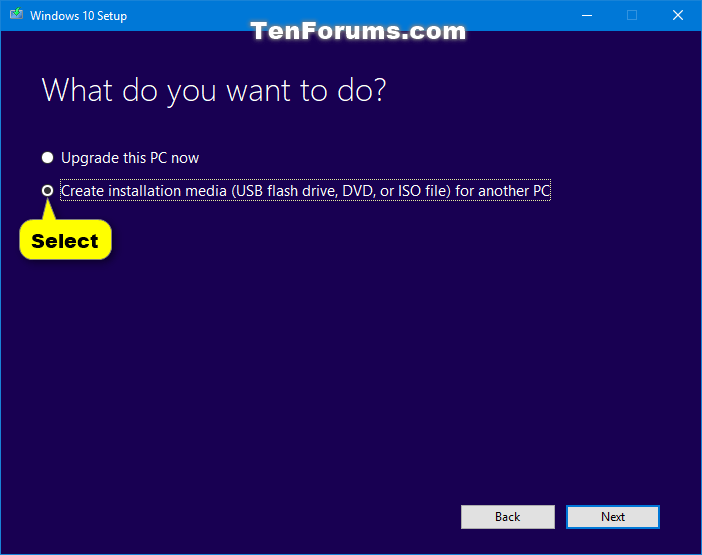
6. Uncheck the Use the recommended options for this PC box. (see screenshot below)
 Leaving the Use the recommended options for this PC box checked will have the Media Creation Tool create a USB flash drive that's the same language, edition, and architecture as the current PC.
Leaving the Use the recommended options for this PC box checked will have the Media Creation Tool create a USB flash drive that's the same language, edition, and architecture as the current PC.
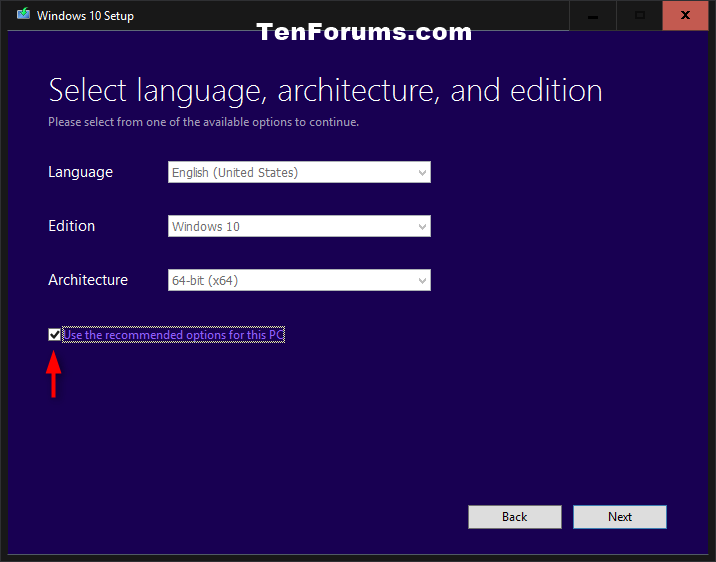
7. Select the Language, Edition, and 32-bit (x86), 64-bit (x64), or both (32-bit and 64-bit on same USB) Architecture you want for the ISO file, and click/tap on Next. (see screenshot below)
 The selected edition can install both the Home and Pro edition.
The selected edition can install both the Home and Pro edition.
Your digital entitlement or product key determines if Home or Pro gets installed during Windows Setup.
If you skip entering a product key during Windows Setup, then you will be prompted to select to install the Home or Pro edition.
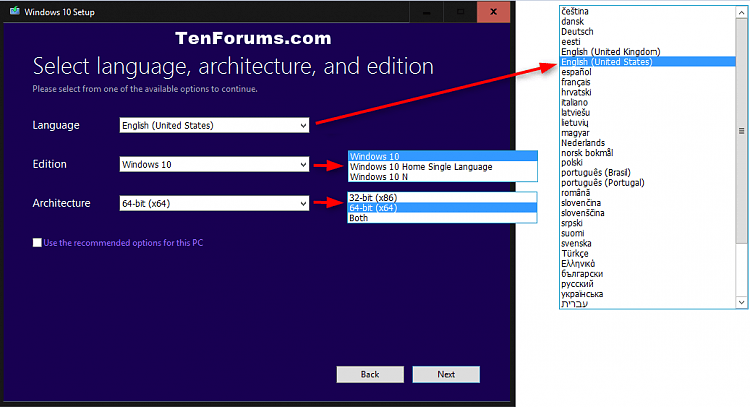
8. Select (dot) USB flash drive, and click/tap on Next. (see screenshot below)
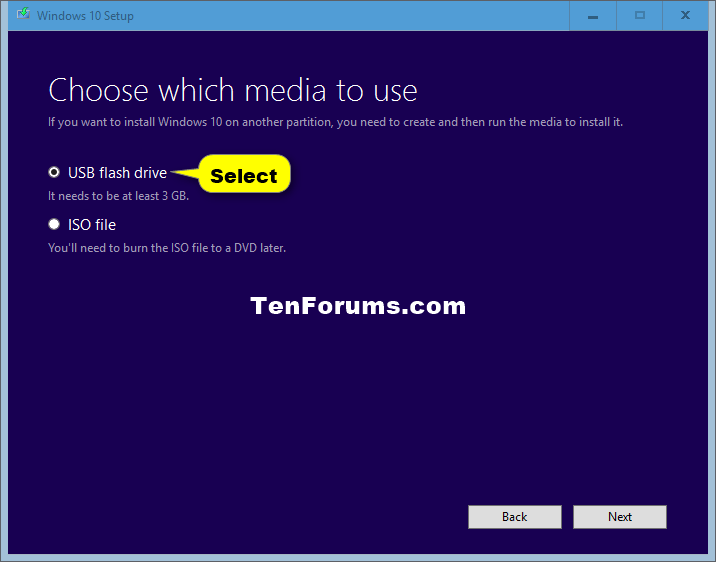
9. Connect your USB flash drive, click/tap on the Refresh drive list link, select the USB flash drive, and click/tap on Next. (see screenshot below)
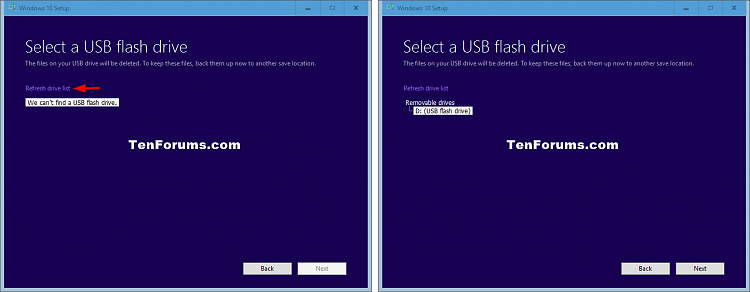
10. It will now start Downloading Windows 10 and Creating Windows 10 media. (see screenshots below)
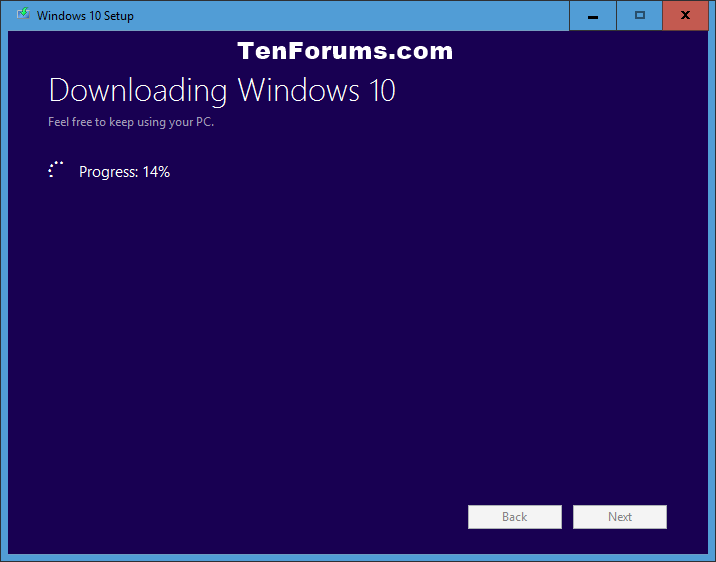
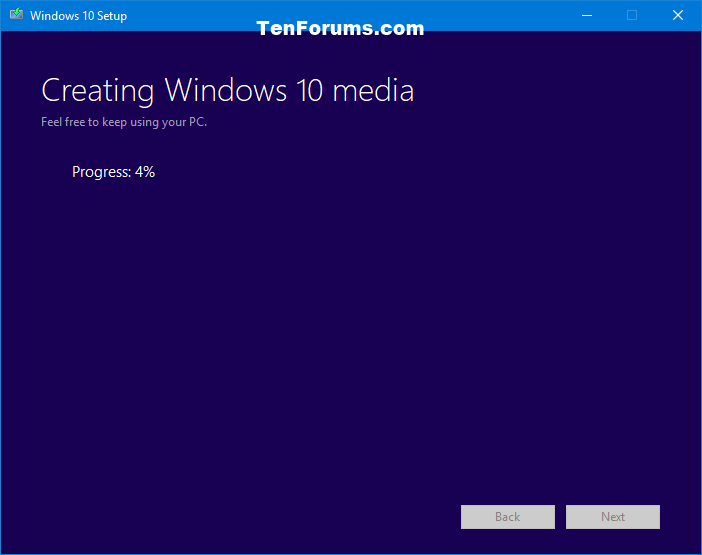
11. When finished, your USB flash drive will be ready. Click/tap on Finish. (see screenshot below)
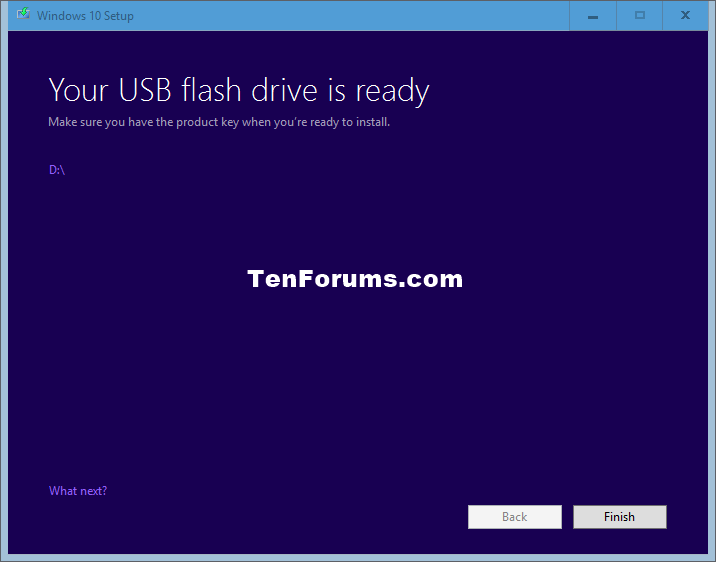
 OPTION TWO
OPTION TWO  Use "Rufus" to create Bootable Window 10 USB for Legacy BIOS and UEFI
Use "Rufus" to create Bootable Window 10 USB for Legacy BIOS and UEFI
1. If you have not already, you will need to download a Windows 10 ISO file.
2. Download the latest version of Rufus, and save it's .exe file to your desktop.
 This is a standalone exe file that doesn't install anything to your PC. For Rufus FAQs, see: rufus FAQ on GitHub
This is a standalone exe file that doesn't install anything to your PC. For Rufus FAQs, see: rufus FAQ on GitHub
3. Connect the USB flash drive that you want to use for this.
4. Run the Rufus .exe file, and click/tap on Yes if prompted by UAC.
5. Do step 6 (UEFI) or step 7 (Legacy BIOS) below depending on if you want to create a bootable USB with or without UEFI support.
 UEFI Requirements:
UEFI Requirements:
A) Set Rufus using the settings below, click/tap on Start, and go to step 8 below. (see screenshot below)

A) Set Rufus using the settings below, click/tap on Start, and go to step 8 below. (see screenshot below)
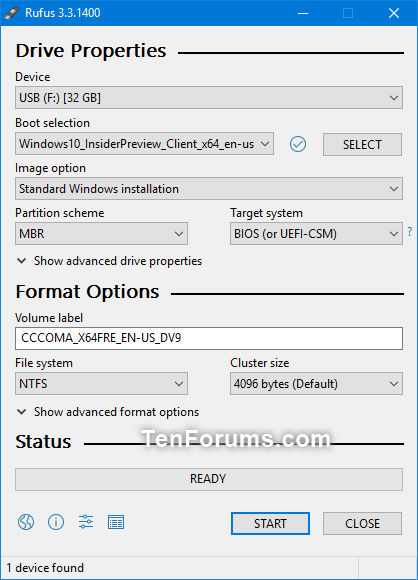
8. Click/tap on OK to confirm. (see screenshot below)
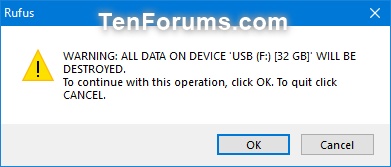
9. Rufus will now start creating the bootable USB flash drive. (see screenshot below)
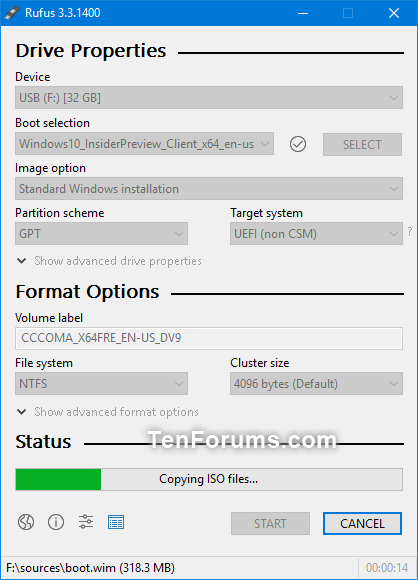
10. When Rufus is "READY" (finished), you can close Rufus. (see screenshot below)
 It could take a little while to finish.
It could take a little while to finish.
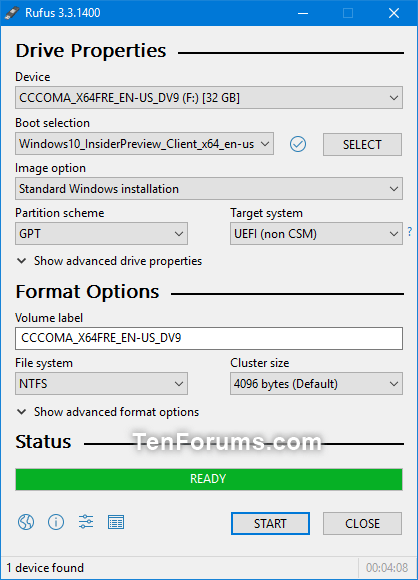
 OPTION THREE
OPTION THREE  Use "Windows 7 USB/DVD Download Tool" to create Bootable Window 10 USB for only Legacy BIOS
Use "Windows 7 USB/DVD Download Tool" to create Bootable Window 10 USB for only Legacy BIOS
1. If you have not already, you will need to download a Windows 10 ISO file.
2. If you have not already, click/tap on the Download button below, and download and install the Windows 7 USB/DVD Download Tool.
3. Run the Windows 7 USB/DVD Download Tool, and click/tap on the Browse button. (see screenshot below)
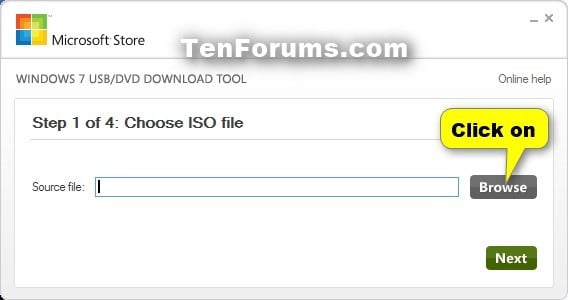
4. Navigate to and select the downloaded Windows 10 ISO file, and click/tap on Open. (see screenshot below)
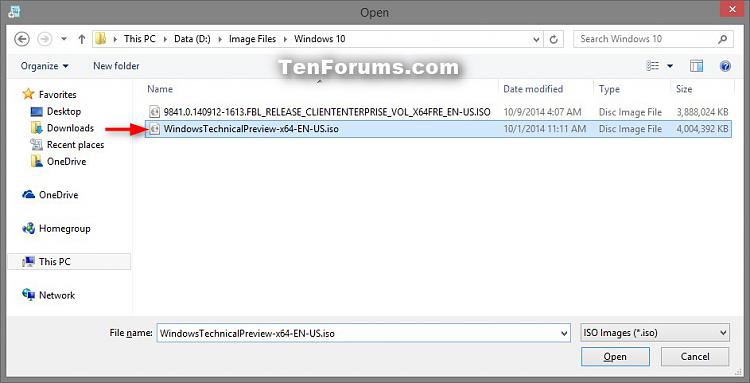
5. Click/tap on Next. (see screenshot below)
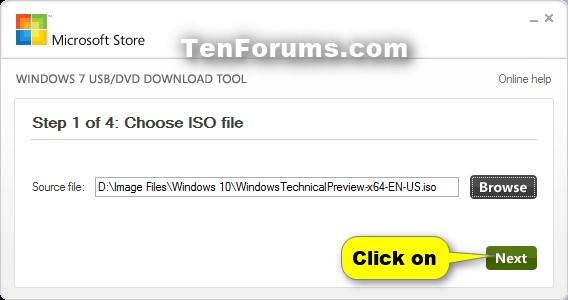
6. Click/tap on USB device. (see screenshot below)
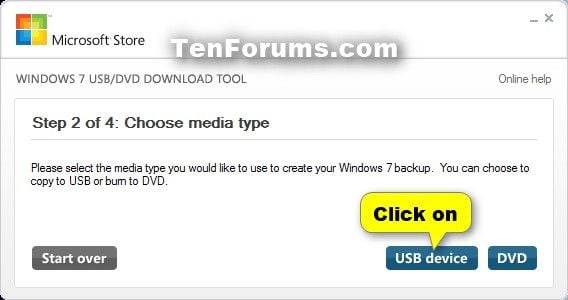
7. Select the drive letter of the USB, and click/tap on Begin copying. (see screenshot below)
NOTE: If the drive letter is not listed in the drop down menu, then click/tap on the refresh button and try again.
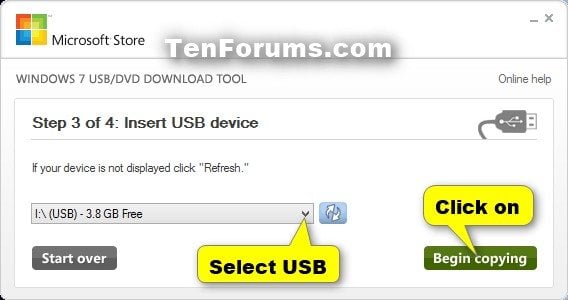
8. If prompted, click/tap on Erase USB Device. (see screenshot below)
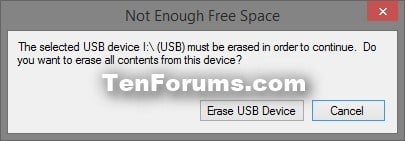
9. If prompted, click/tap on Yes. (see screenshot below)
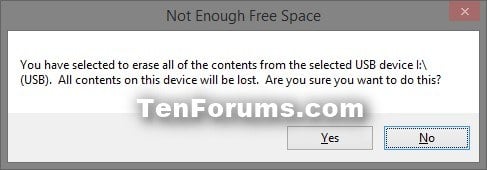
10. When successfully finished, you can close the Windows 7 USB/DVD Download Tool.
NOTE: It could take a little while to finish.
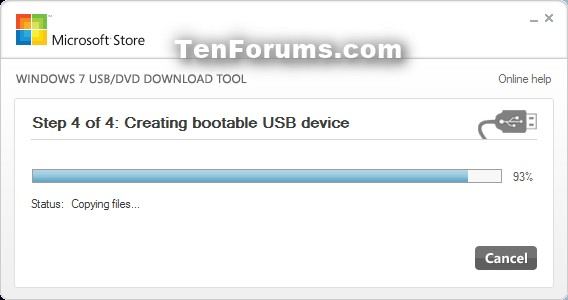
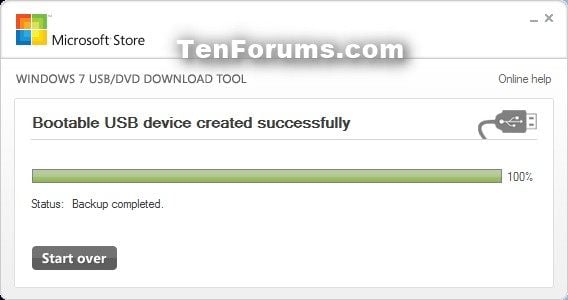
That's it,
CONTENTS:
- Option One: Use Media Creation Tool to create Bootable Windows 10 USB for Legacy BIOS and UEFI
- Option Two: Use "Rufus" to create Bootable Window 10 USB for Legacy BIOS and UEFI
- Option Three: Use "Windows 7 USB/DVD Download Tool" to create Bootable Windows 10 USB for only Legacy BIOS
 OPTION ONE
OPTION ONE 
This option will use the Media Creation Tool from Microsoft to download an ISO file and create a bootable USB flash drive that is 32-bit, 64-bit, or both, and be used to install Windows 10 with or without UEFI.
Before you begin
- Make sure you have:
- An internet connection (internet service provider fees may apply).
- Sufficient data storage available on a computer, USB or external drive for the download.
- A blank USB with at least 4 GB (32-bit or 64-bit) or 8 GB (both 32-bit and 64-bit) of space if you want to create media. We recommend using a blank USB, because any content on it will be deleted.
- Read the System Requirements.
- If you will be installing the operating system for the first time, you will need your Windows product key (xxxxx-xxxxx-xxxxx-xxxxx-xxxxx). For more information about product keys and when they are required, visit the FAQ page.
- For Enterprise editions please visit the Volume Licensing Service Center.
1. Click/tap on the Download button below to go to Microsoft, and click/tap on the Download tool now button at Microsoft's site.
2. Save the MediaCreationTool1809.exe file (version 10.0.17763.1) to your desktop, and run it. (see screenshot below)

3. If prompted by UAC, click/tap on Yes.
4. Click/tap on Accept for the license terms. (see screenshot below)

5. Select (dot) Create installation media (USB flash drive, DVD, or ISO file) for another PC, and click/tap on Next. (see screenshot below)

6. Uncheck the Use the recommended options for this PC box. (see screenshot below)
 Leaving the Use the recommended options for this PC box checked will have the Media Creation Tool create a USB flash drive that's the same language, edition, and architecture as the current PC.
Leaving the Use the recommended options for this PC box checked will have the Media Creation Tool create a USB flash drive that's the same language, edition, and architecture as the current PC.
7. Select the Language, Edition, and 32-bit (x86), 64-bit (x64), or both (32-bit and 64-bit on same USB) Architecture you want for the ISO file, and click/tap on Next. (see screenshot below)
 The selected edition can install both the Home and Pro edition.
The selected edition can install both the Home and Pro edition.Your digital entitlement or product key determines if Home or Pro gets installed during Windows Setup.
If you skip entering a product key during Windows Setup, then you will be prompted to select to install the Home or Pro edition.

8. Select (dot) USB flash drive, and click/tap on Next. (see screenshot below)

9. Connect your USB flash drive, click/tap on the Refresh drive list link, select the USB flash drive, and click/tap on Next. (see screenshot below)

10. It will now start Downloading Windows 10 and Creating Windows 10 media. (see screenshots below)


11. When finished, your USB flash drive will be ready. Click/tap on Finish. (see screenshot below)

 OPTION TWO
OPTION TWO 
1. If you have not already, you will need to download a Windows 10 ISO file.
2. Download the latest version of Rufus, and save it's .exe file to your desktop.
 This is a standalone exe file that doesn't install anything to your PC. For Rufus FAQs, see: rufus FAQ on GitHub
This is a standalone exe file that doesn't install anything to your PC. For Rufus FAQs, see: rufus FAQ on GitHub3. Connect the USB flash drive that you want to use for this.
4. Run the Rufus .exe file, and click/tap on Yes if prompted by UAC.
5. Do step 6 (UEFI) or step 7 (Legacy BIOS) below depending on if you want to create a bootable USB with or without UEFI support.
6. To Create Bootable UEFI USB Flash Drive for Installing Windows 10 with UEFI
 UEFI Requirements:
UEFI Requirements:- 64-bit Windows 10 ISO file. 32-bit is not supported.
- At least a 8GB USB flash drive depending on how large the ISO file is.
- To boot from an external UEFI USB flash drive, be sure to temporarily disable Secure Boot and Fast Boot (if applicable) in your UEFI firmware settings until the Windows installation is finished.
A) Set Rufus using the settings below, click/tap on Start, and go to step 8 below. (see screenshot below)
- Under Device, select the USB flash drive you want to format and use.
- Under Boot selection, click/tap on the SELECT button, and navigate to and select your 64-bit Windows 10 ISO file.
- Under Image option, select Standard Windows installation.
- Under Partition scheme, select GPT.
- Under Target system, select UEFI (non CSM).
- Under Volume label, you can enter any name you like for the USB flash drive, or leave the default name.
- Under File system, select FAT32 (if able). If the file is larger than 4GB, you will only be able to select NTFS.
- Under Cluster size, select the (Default) (ex: 4096 bytes) it has listed.

7. To Create Bootable USB Flash Drive for Installing Windows 10 using Legacy BIOS (without UEFI)
A) Set Rufus using the settings below, click/tap on Start, and go to step 8 below. (see screenshot below)
- Under Device, select the USB flash drive you want to format and use.
- Under Boot selection, click/tap on the SELECT button, and navigate to and select your 64-bit Windows 10 ISO file.
- Under Image option, select Standard Windows installation.
- Under Partition scheme, select MBR.
- Under Target system, select BIOS (or UEFI-CSM).
- Under Volume label, you can enter any name you like for the USB flash drive, or leave the default name.
- Under File system, select NTFS.
- Under Cluster size, select the (Default) (ex: 4096 bytes) it has listed.

8. Click/tap on OK to confirm. (see screenshot below)

9. Rufus will now start creating the bootable USB flash drive. (see screenshot below)

10. When Rufus is "READY" (finished), you can close Rufus. (see screenshot below)
 It could take a little while to finish.
It could take a little while to finish.
 OPTION THREE
OPTION THREE 
1. If you have not already, you will need to download a Windows 10 ISO file.
2. If you have not already, click/tap on the Download button below, and download and install the Windows 7 USB/DVD Download Tool.
3. Run the Windows 7 USB/DVD Download Tool, and click/tap on the Browse button. (see screenshot below)

4. Navigate to and select the downloaded Windows 10 ISO file, and click/tap on Open. (see screenshot below)

5. Click/tap on Next. (see screenshot below)

6. Click/tap on USB device. (see screenshot below)

7. Select the drive letter of the USB, and click/tap on Begin copying. (see screenshot below)
NOTE: If the drive letter is not listed in the drop down menu, then click/tap on the refresh button and try again.

8. If prompted, click/tap on Erase USB Device. (see screenshot below)

9. If prompted, click/tap on Yes. (see screenshot below)

10. When successfully finished, you can close the Windows 7 USB/DVD Download Tool.
NOTE: It could take a little while to finish.


That's it,



